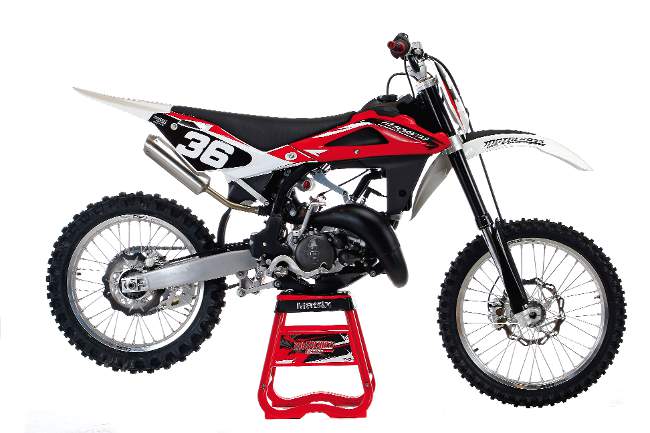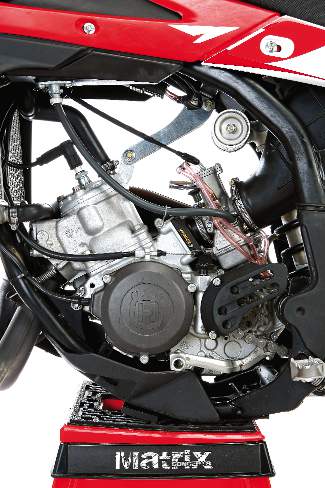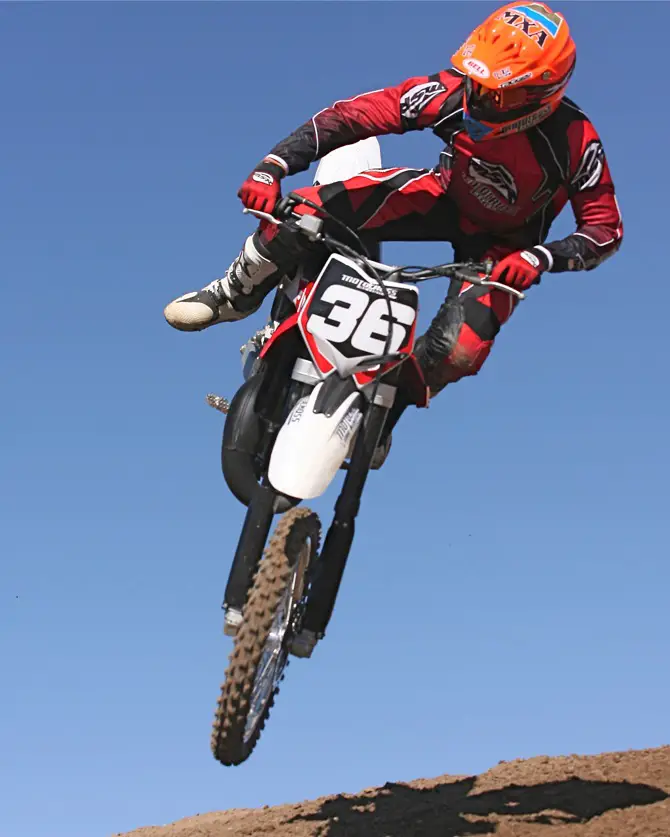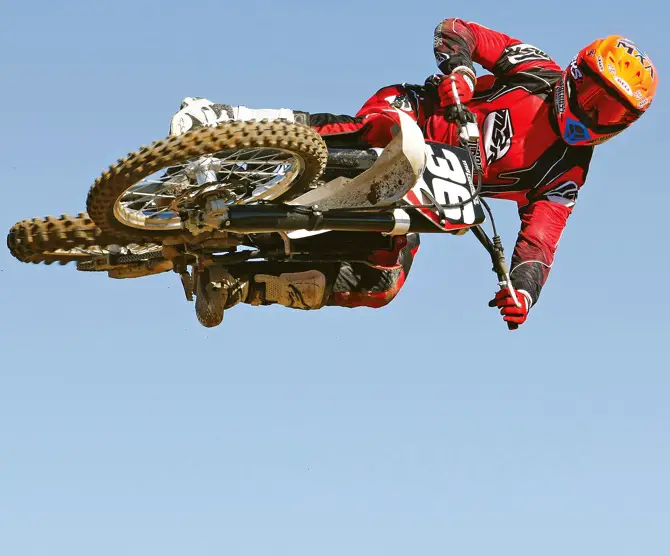MXA’S 2012 HUSQVARNA CR144 MOTOCROSS TEST: IT’S LIKE BUYING TWO BIKES FOR THE PRICE OF ONE

Q: ARE THE 2012 HUSQVARNA CR125 AND CR144 THE SAME BIKE?
A: They are the same bike, but both start life as a CR125! When you buy a CR125 in the USA, Husqvarna automatically includes the 144cc kit with the necessary cylinder, head, piston and gaskets. Ten years ago, the CR144 would have been considered a cheater bike, but for the current races that average consumers enter, the 144 is often a legal option. For our test, the MXA wrecking crew skipped straight to the CR144 kit in order to run the Husqvarna in its best configuration possible.
As for full-size Husqvarna motocross bikes, Husky does not make a CR250 or CR300. The only current option is converting a WR300 enduro two-stroke into a motocrosser, which MXA has done with some success.
Q: IS THE CR125/144 AFFORDABLE?
A: The MSRP on the 2012 Husqvarna CR125 is $5999. For comparison, the KTM 150SX is $6399, the KTM 125SX is $6299 and the Yamaha YZ125 is $6290. The cheapest 250F you can buy is Husqvarna’s TC250 at $6999, which is $250 less than the next cheapest 250F (the YZ250F). It is impressive that the underdog is able to beat the “Big Five” brands on price. The included 144cc kit would cost an additional $951.43, which is what you would have to pay to upgrade an older model CR125 or WR125, thus the $5999 price tag is actually an even better deal than it looks on the surface.
Q: HAS HUSQVARNA KEPT UP WITH THEIR 125 TWO-STROKE DEVELOPMENT?

2012 Husky CR125/144: It doesn’t boast a lot of new features, but overall, Husqvarna has kept their tiddler up to date, competitive and affordable.
A: For the most part, the CR125 is up to date, but some of the parts are a little long in the tooth. Husqvarna is well established in the European offroad market, but their goal in the USA is to get their name back on the map and try to make a dent in motocross. Even though they haven’t imported a large number of CR125s to the USA in recent years, that doesn’t mean they haven’t been developing the CR125 and WR125?which share most of their components?in Europe. They have bided their time, wanting to hit the USA market with a winner. The Husqvarna engineers have tried to keep pace with the rapid developments of the KTM 125SX and ahead of the glacial R&D of the YZ125.
The biggest barrier to Husqvarna’s 125cc R&D funds lies ahead, because the Husky 125 engine gets its best use in European commuter bikes, and tighter emission regulations on the small street bikes have made it difficult for the CR125?not because the motocross model has to meet any emissions requirements, but because the core commuter market for the little two-stroke does. This could hurt production numbers and corresponding R&D dollars.
Q: WHAT’S NEW WITH THE CR144?
 |
| Split personality: This is two engines in one. The bike sits on the showroom floor as a 125, but a 144 cylinder, head and piston is thrown in with every bike sold at no extra cost. |
A: A year ago the 2011 Husqvarna CR125 got a modified frame with a streamlined engine cradle. It also got new motor mounts and matching cylinder head fittings. The 2011 also got a water-resistant air-filter housing and updated Kayaba 48mm forks. Yes, this is old news to some, but new to us since we didn’t test the 2011 CR125.
For 2012, there were only three updates on the Husqvarna CR125:
(1) Big-bore kit. As mentioned, the USA version comes with the 144cc kit in the box. The displacement can be bumped up from 124.8cc to 144cc by an extra 4 millimeters of bore (with the supplied cylinder). This is like having two bikes for the price tag of one, and that’s a big deal.
(2) Gusseting. Husqvarna reinforced the steering-head area of the frame with gussets.
(3) Cosmetics. The colors and style of the 2012 Husqvarnas have been changed to black frames, silver Excel rims and new graphics.
Q: HOW WOULD WE DESCRIBE THE HUSQVARNA CR144 POWERBAND?
A: The CR144 had a high-rpm sweet spot that met with nods of approval from all of the diehard MXA two-stroke racers. A guy who bleeds premix, scoffs at the broad power of four-strokes and disparages thumper pilots for their lazy riding technique will praise the CR144’s power delivery. Whether a two-smoke maven or first-timer, the high-rpm power of the CR144 will put a smile on anyone’s face…when the engine comes on the pipe.
Don’t confuse the CR144’s narrow window of peak power for a light switch-style of power, though. It didn’t come on the pipe instantly or fall off without warning; it tried to run across a wide range. But, MXA test riders had to rev the engine through a lot of rpm to get up to the business end of the CR144. But once in the top end of the powerband, they started to get somewhere.
Every tester was tempted to shift early, but it was best to wait a split-second longer than your first best guess. The sweet spot is way up there. We geared the CR144 down one tooth by going up on the number of rear-sprocket teeth. That change got us to the sweet spot sooner and enhanced the usability of second gear. It is much better geared down than stock.
Q: HOW DID THE HUSQVARNA CR144 STACK UP AGAINST THE?COMPETITION?
A: Is the 2012 Husqvarna CR144 faster than the YZ125 and KTM 125SX? It better be, since it has a larger displacement. It would be an ugly mark on the report card if it got beat by the smaller displacement bikes?and it didn’t get beat. The CR144 had an unmistakable advantage in head-to-head comparisons with the KTM 125SX when test riders charged down the big straights and up tall hills.
But that leads us to the 2012 KTM 150SX. The oversize KTM 150SX has an almost four-horsepower boost over the KTM 125SX. We must admit that we felt that the Husqvarna CR144 was a solid race bike, but it will have to get up earlier in the morning to outgun the potent KTM 150SX.
The classic question of whether it can compete against 250Fs gets the classic answer: Yes. It could hang in there, but the CR144 pilot would have to do everything just right?and that starts from the moment he buckles his boots.

Q: HOW GOOD ARE THE 2012 HUSQVARNA JETTING SPECS?
A: On a cold day with a Pro-level tester wringing the bike out, the CR125 would ping a little. We considered going to one richer on the main, but found it easier to keep Pros off of the bike?because it didn’t ping in the hands of Vet, Novice and Intermediate riders. All in all, the 2012 CR144’s jetting was in the ballpark.
Here are the stock specs of the Mikuni TMX 38mm carburetor:
Mainjet: 460
Pilot jet: 35
Needle: 6BFY43
Clip: Third slot
Air screw : 1?1/4 turns out
Leak jet: 80
Q: HOW WELL DOES THE CR144 HANDLE?
A: This is somewhat of a loaded question, because even feeble riders can throw lightweight 125s around. The truth is that Husqvarna has produced a neutral-handling chassis. A lot of this comes from the fact that the front and rear suspension were evenly sprung?with neither end overpowering the other. The CR125 wasn’t prone to oversteer or understeer and felt comfortable all around. This is the type of chassis that doesn’t ever cause a rider to go “wow,” but they don’t go “owww.” either. After getting sag dialed in and sliding the forks in the clamps, we were happy.

Skyscraper: Originally configured as a 125, we were surprised when the gearing was too tall for the bike in 144cc trim.
Q: HOW GOOD IS THE HUSQVARNA CR144 SUSPENSION?
A: Surprisingly good for its target audience. Thanks to its lower weight and low horsepower, the CR144 doesn’t demand too much from its forks and shock. In fact, the overall settings were on the firm side for the typical featherweight 125 pilot. For our smaller test riders, we softened things up and think that if you are under 150 pounds, you might consider going to softer spring rates.
The Kayaba front and Sachs rear combo was significantly plusher and better performing than the KTM 125/150’s WP equipment, but not up to par with Yamaha’s SSS suspension.
Q: WHAT WERE OUR BEST FORK SETTINGS?
A: Here is what MXA ran for hardcore racing (stock settings are in parentheses):
Spring rate: 0.43 kg/mm
Oil height: (352cc)
Compression: 15 clicks out (12 clicks out)
Rebound: 8 clicks out (6 clicks out)
Fork-leg height: 4mm up from cap
Q: WHAT WERE OUR BEST SHOCK SETTINGS?
A: Here is what MXA ran for hardcore racing (stock settings are in parentheses):
Spring rate: 5. kg/mm
Hi-compression: 9 clicks out (7 clicks out)
Lo-compression: 18 clicks out (13 clicks out)
Rebound: 8 clicks out (11 clicks out)
Race sag: 100mm
Q: HOW WAS THE GEARING?
A: Initially, we were very confused by the tall gearing of the CR144. Yes, many manufacturers tend to spec a tall final drive in the name of general rider friendliness. Yes, Europeans are known to prefer tall gearing, but the base of this bike was designed as a 125. Yes, skipping straight to the more powerful 144 top end would allow for the extra power to pull taller gears?but we added the 144cc kit to the basic CR125 chassis?so this gearing, which didn’t work well on the 144, would be a disaster on the CR125.
Further gearing confusion ensued because of the narrow nature of the CR144’s powerband. Some test riders thought that going even taller would enable them to stay in one gear longer?even if those gears were first and second. However, since the power was high in the rpm range, and testers were shifting to first gear in a lot of turns, lowering the gearing was the best way to go.
Swapping the 13/50 sprocket combination for a 13/51 allowed us to stay in second in more turns and get on the pipe much easier to grab third.
Q: CAN YOU GET HUSQVARNA PARTS?
A: We don’t ask this question to be negative, but when we built our WR300 two-stroke motocross bike two years ago, we waited three weeks for a base gasket. Since then, Husqvarna has added new parts managers, consolidated warehouses and used their race team to determine the frequency of use of most of the parts. Husqvarna North America knows that they had a problem, because virtually every person at Husky USA is a motorcycle racer. Husky claims that the parts problems of the past 20 years have been solved?which is like giving the MXA wrecking crew the go-ahead to start breaking things.

Sachs: TC250s get Kayaba shocks, but the two-strokes keep the Sachs unit. It’s foreign to tuners, but works well stock.
Q: HOW CAN YOU MAKE THE CR144 BETTER?
A: In addition to spec parts, Husky has a hop-up catalog. There is a cut-down seat, adjustable offset triple clamps, fancy footpegs and lots of other trick parts. As with most two-strokes, the first place to start is with an aftermarket pipe and a gearing change.
Both FMF and Pro Circuit make pipes for this bike, and we found a wide variety of sprocket choices?including a Supersprox steel/aluminum hybrid.
Q: WHAT DID WE HATE?
A: The hate list:
(1) Brake pedal. We don’t know if it was a poor casting or just a collision, but we broke the rear brake pedal without noticing it. The next step is getting a brake snake. Oh, by the way, Husqvarna had the brake pedal in stock.
(2) Gas cap . The rubber seal can pop loose. If it falls out completely, it will cause a major leak. And if it falls part way out, it could cause the cap to cross-thread.
(3) Grips. One of the biggest pet peeves of a test rider is when a grip spins on the handlebars. It should never happen on a brand-new bike, but it did.
(4) Front tire . Testers could live with the Michelin Starcross M3 rear, but they whined a lot about the M3 front tire.
(5) Gearing. The gearing was a puzzle. It was too tall for the 144 kit, so it must be super tall for the bike in 125cc form.

Q: WHAT DID WE LIKE?
A: The like list:
(1) Price. You would expect that an exotic brand?selling less bikes and offering a wider lineup of machines?would have to charge more for their bikes than the Big Five brands. Not so. Additionally, you would think that throwing in a bigger cylinder, piston and rings would cause the price to rise. Not so. The 2012 Husqvarna CR125/144 is the least expensive bike in its category.
(2) Weight. Curb weight is a claimed 206.8 pounds. The KTM tiddlers are 202 pounds and the Yamaha is under 200. Even though it’s the chubby kid on the team, it feels light from the saddle.
(3) Room. There is so much extra room in the engine compartment you could store a lunch box down there and have a mid-moto snack. Four-stroke mechanics can only imagine what it’s like to be able to easily access the engine, carburetor, spark plug and rear shock.
(4) Powerband. With the power up high, it increases the hero factor and fun factor of a little bike that likes to be held wide open.
Q: WHAT DO WE REALLY THINK?
A: First and foremost, what the world needs is more under-$6000 motocross bikes. This is the only one?and it is really two bikes in one. Small-bore two-strokes are the kind of bikes that young riders need to get a foothold in the sport. They have the perfect weight, power and simplicity to teach young riders the ropes of racing. They don’t cost an arm and a leg to race?and the 2012 CR125 actually comes with one free rebuild, and a displacement boost at the same time.
Is this the best bike built? Is a Porsche better than a Ferrari? It all depends on where you are coming from, where you are heading to and what you are looking for. This is the affordable, easy-to-maintain, entry-level race bike that every industry know-it-all says we need.
If you are a 16-year-old on a budget (or have one at home), pay attention to the know-it-alls, because this could be the best bike for you, your budget and your riding style.





Comments are closed.